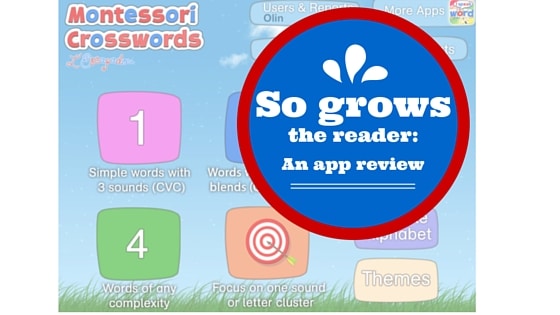
While hundreds of apps have been created for the teaching of reading, most of them are instructionally so poor, that after testing them, I simply delete them from my phone or iPad. Not even worth 5 minute’s of a child’s time.
Harsh!
So, when I encounter an app that’s effective, fun, and easy-to-use, I get very excited.
“Perhaps a little too excited,” you non-reading-geeks might be thinking?
But all of my trial-and-error can serve your teaching purposes, starting here with the massively useful iOS and android app, Montessori Crosswords ($3.99).
The Old Beginnings of the Montessori Crosswords App
Inspired by the approach began by physician and revolutionary educator Maria Montessori nearly 100 hundred years ago, the Montessori Crosswords app guides beginning, struggling, or developing readers to spell words with the support and emphasis of the sounds of the letter-sounds. This approach integrates many essential skills young readers need, simultaneously teaching:
- How our written language system or code works—AKA the alphabetic principle (letters are pictures or spellings of sounds in words),
- Letter-sound or phonics knowledge, and
- Phonemic (individual sound-based) segmentation (“cat” = /c/ /a/ /t/).
These are the pivotal principles that undergird Reading Simplified and we’ve written about them previously, as in the post, Integrate, Don’t Isolate and Don't Start at the Very Beginning. 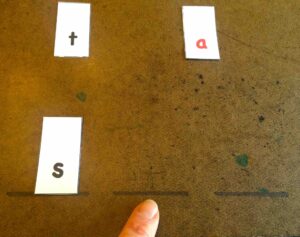
Indeed, the entire app is a digital version of our Reading Simplified activity, “Build It.”
Plus, the variety and fun it brings to instruction is priceless!
Dr. Montessori reasoned that spelling by sounds is the doorway to both reading and writing. Her deductions have been verified by researchers, too (for instance, see here). The Montessori Crosswords app activities encourage children to perceive each sound they hear in a word and then match that sound to a particular letter or digraph (2 letter combinations, such as “ch” or “oa”). 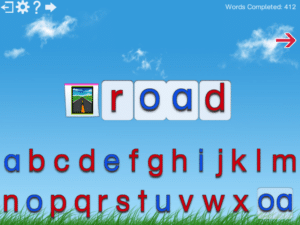
So Grows the Reader
What’s even more striking about this app, however, is that it is designed to grow with the reader.
In contrast to most early reading apps on the market, Montessori Crosswords does not simple stop with CVC (consonant-vowel-consonant, as in “cat”) words. After children master the phonemic challenge of CVC words, they can begin to focus on learning Advanced Code information (phonics informatin that goes beyond simply consonants and short vowels, such as
/oa/ = “ow,” “oa,” “o,” “o_e”.
The app allows you to select from a large list of sounds on which to focus, as in each of the short or long vowels, other vowel sounds (/ar/, /oi/, or /er/), and even consonant digraphs (“ck,” “sh,” “tch,” “th,” “ng,” and “wh”). As your reader expands his knowledge of our written code, he can continue to be challenged to learn more and more phonics spellings.
This adapts perfectly for our Reading Simplified lessons!
For example, in Reading Simplified, after a beginning or struggling reader develops some ability to blend and segment 3-sound words and recognizes many consonants and short vowels, she’s ready for Advanced Phonics information—the sound /oa/ (see our Streamlined Pathway below). 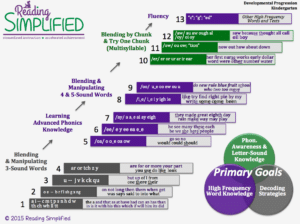 After some written work and reading learning the /oa/ sound’s various spellings, I will often switch to Montessori Crosswords and select,
After some written work and reading learning the /oa/ sound’s various spellings, I will often switch to Montessori Crosswords and select,
“Focus on one sound or letter cluster,” 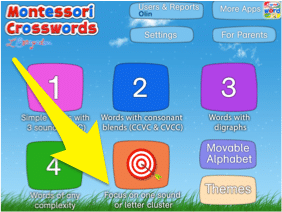 and then select “long o sound – as in rose or soap.”
and then select “long o sound – as in rose or soap.” 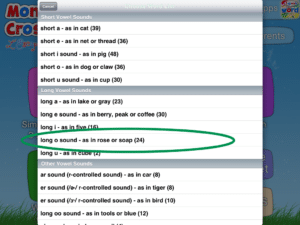 Many kids love the “break” of playing with Montessori Crosswords because the learning is easy, given the supports provided. Also, they love the small surprise that awaits them after they spell a word:
Many kids love the “break” of playing with Montessori Crosswords because the learning is easy, given the supports provided. Also, they love the small surprise that awaits them after they spell a word: 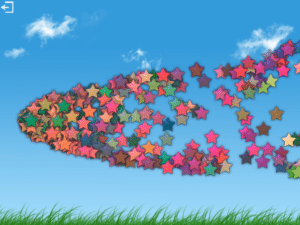
They can create and manipulate the colorful designs that populate the screen in unlimited ways.
Each new word spelled = an opportunity to play with a new design:
Yep, just creative fun to keep the motivation high.
To avoid losing too much instructional time, though, I’ve changed the
–>Settings,
–> “Interactive Animation Duration” to
–> “8 seconds.”
This change causes the app to automatically switch back to instruction after 8 seconds of playful “drawing.”
The main teaching interface is attractive, easy-to-use, and instructionally sound. The app shows a picture and says a word, while revealing all or much of the alphabet, plus any digraphs (2-letter graphemes) that may be necessary to spell the word. If the child taps on a letter or digraph, that sound is clearly pronounced. If the child tries to move the incorrect letter or digraph into the boxes, it bounces back.
Built in error correction, a la Montessori!
Grouping Phonics Information by Sound
Here’s an example of a couple of /oa/ sound words already built.
In the “pillow” example above, you can observe how the digraphs are linked as a unit.
So helpful!
But so rare in reading educational materials.
Montessori Crosswords drives instruction by sounds, not letters or letter names, so each sound is a separate unit—
p i ll ow
rather than
p i l l o w.
This is so important, especially if you want to have a fast start with a beginner or if you are supporting someone who is struggling or could be diagnosed with dyslexia.
In the above example, notice how several spellings of the /oa/ sound are being presented during the same lesson.
This is just how we like to roll at Reading Simplified, too.
Present the main spellings of an Advanced Code sound, such as /oa/ or /er/, and let the child begin to memorize all these spellings as part of one memory “file.” Introduce the spellings together, and the right files get grouped together in her brain.
This is another way that teachers using Reading Simplified techniques save instructional time and move kids rapidly into real reading.
We have worked with teachers who are afraid that presenting more than 1 or 2 spellings at a time will overwhelm their learner. So, they gradually drip this information out to children. Thus, only some children figure out that they should group this information in their memory banks.
But we have never encountered a child who could not handle the concept that one sound can have several spellings.
No, each spelling doesn't get learned immediately in the first lesson. But with a consistent presentation of one sound—several spellings, they memorize the information more quickly.
Could Be Tweaked?
[Update (1/26/16): I just corresponded with Pierre Abel, the creator of Montessori Crosswords and he intends to change the following limitation for the next update. Yeah! And thank you Pierre!]
The main criticism I have of the app right now is that a subset of vowel digraphs are not grouped together as a unit.
For instance, the “oe” in “toe” and “hoe” and the “o_e” in “rose” and “bone” are not linked as one sound or one digraph.
Pity.
This can make building these words very tricky for a beginner or a developing speller. In general, the lesson should be more about hearing the sounds in words and noticing the spellings that match each phoneme. I don’t use it as a spelling lesson (unless the student is further along the literacy path).
Given this limitation, I just step in here and point with my fingers, “These together make the /oa/ sound in this word.”
Nevertheless, the bulk of the app is excellent and so effective for both beginners or developing readers. That’s why Montessori Crosswords is a Reading Simplified Top 7 Apps for Teaching Reading award winner.
I use it almost every day.
Well, truthfully, not on the weekends cuz I’m trying not to be a workaholic. 😉
Have you had success or trouble with Montessori Crosswords? Please comment below and let your peers know so we can all optimize our instructional time!


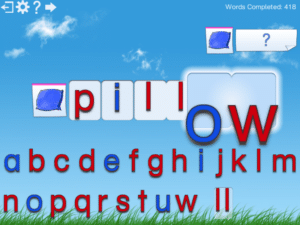

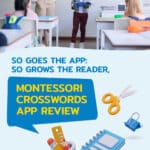
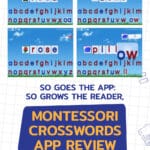

It IS a pity he doesn’t have the digraphs linked. You used the example of vowel digraphs, but I hope when he fixes the vowel digraphs if he will fix the consonants too. (I downloaded the free version to check it out before buying it. My youngest reader is used to having digraph tiles for “ch,” “ck,” “th,” etc and will soon be getting “ar,” “er,” “ur,” “or” tiles… So although the lure of the screen would give additional reinforcement of what we do, I’m not sure it’s worth the time lost to a screen. For instance, the child is asked to spell “chick.” Even though the two rectangles light up when the sound is said, you have to drag the “c” and then the “h” whilst they make their primary sounds. Confusing.) If anyone is looking for a similar idea that is not on a screen, All About Reading uses magnetic letter tiles for similar activities. Of course, a teacher/parent is needed to aid…
Hm. Maybe the full app (that is not free) has some of it fixed? You screen shots DO look like they could choose a letter grouping to make a sound…
Thanks for the comments, Ginger. Yes, these quirks in any app/reading text can be confusing for beginners. Based on what you wrote, I’m wondering if the free version is an older version of the paid one. For my version of Montessori Crosswords, the “ch” and “ck,” for instance, are on the bottom right of the keyboard as an option for the student to select in one stroke.
Most of the vowel and consonant digraphs are one unit, or one sound, in my version. I meant to write above there are just a couple digraphs like the “oe” in “toe” that aren’t linked.
As for the risk of too much time with screens, good point. If I change the setting for the free play with the art to be limited, then I think there’s a good balance of time in text for most children with pure fun. But each case is unique.
I like to make a purchase of the app.
Great! Please head here to find how to purchase for iPhone or google play
American English, but most words are beginner words where there is no difference in the spellings.